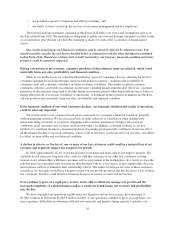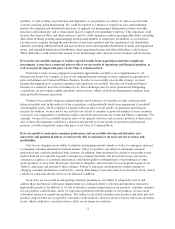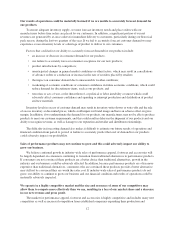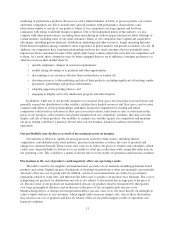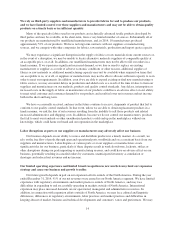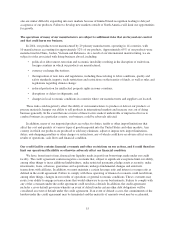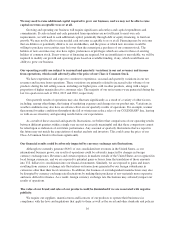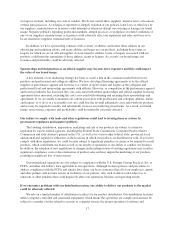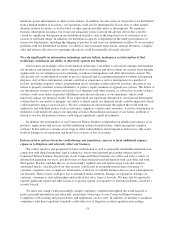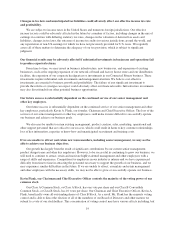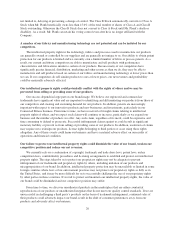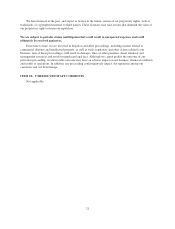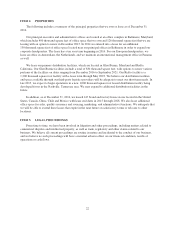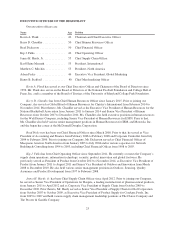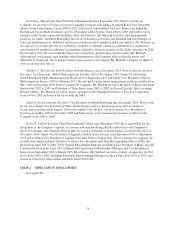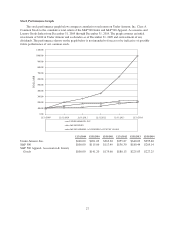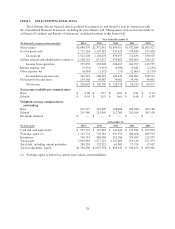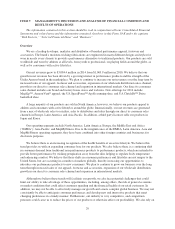Under Armour 2014 Annual Report Download - page 30
Download and view the complete annual report
Please find page 30 of the 2014 Under Armour annual report below. You can navigate through the pages in the report by either clicking on the pages listed below, or by using the keyword search tool below to find specific information within the annual report.not limited to, delaying or preventing a change of control. The Class B Stock automatically converts to Class
A
Stock when Mr. Plank beneficially owns less than 1
5
.0% of the total number of shares of Class A and Class B
Stock outstanding. Otherwise the Class B Stock does not convert to Class A Stock until Mr. Plank’s death o
r
disability. As a result, Mr. Plank can retain his voting control even after he is no longer affiliated with th
e
C
ompany.
A number of our fabrics and manufacturin
g
technolo
g
y are not patented and can be imitated by our
competitors.
T
h
e
i
nte
ll
ectua
l
propert
y
r
igh
ts
i
nt
h
e tec
h
no
l
o
gy
,
f
a
b
r
i
cs an
d
processes use
d
to manu
f
acture our pro
d
ucts
are
g
enera
lly
owne
d
or contro
ll
e
dby
our supp
li
ers an
d
are
g
enera
lly
not un
i
que to us. Our a
bili
t
y
to o
b
ta
i
n patent
p
rotect
i
on
f
or our pro
d
ucts
i
s
li
m
i
te
d
an
d
we current
ly
own a
li
m
i
te
d
num
b
er o
ff
a
b
r
i
c or process patents. As
a
r
esu
l
t, our current an
df
uture compet
i
tors are a
bl
e to manu
f
acture an
d
se
ll
pro
d
ucts w
i
t
h
per
f
ormanc
e
c
h
aracter
i
st
i
cs an
df
a
b
r
i
cat
i
ons s
i
m
il
ar to certa
i
no
f
our pro
d
ucts. Because man
y
o
f
our compet
i
tors
h
av
e
s
ig
n
ifi
cant
ly g
reater
fi
nanc
i
a
l
,
di
str
ib
ut
i
on, mar
k
et
i
n
g
an
d
ot
h
er resources t
h
an we
d
o, t
h
e
y
ma
yb
ea
bl
eto
manu
f
acture an
d
se
ll
pro
d
ucts
b
ase
d
on certa
i
no
f
our
f
a
b
r
i
cs an
d
manu
f
actur
i
n
g
tec
h
no
l
o
gy
at
l
ower pr
i
ces t
h
an
we can. I
f
our compet
i
tors
d
ose
ll
s
i
m
il
ar pro
d
ucts to ours at
l
ower pr
i
ces, our net revenues an
d
pro
fi
ta
bili
ty
cou
ld b
e mater
i
a
ll
ya
d
verse
l
ya
ff
ecte
d
.
O
ur intellectual property ri
g
hts could potentially conflict with the ri
g
hts of others and we may be
prevented from sellin
g
or providin
g
some of our products.
Our success
d
epen
d
s
i
n
l
ar
g
e part on our
b
ran
di
ma
g
e. We
b
e
li
eve our re
gi
stere
d
an
d
common
l
aw
tra
d
emar
k
s
h
ave s
ig
n
ifi
cant va
l
ue an
d
are
i
mportant to
id
ent
ifyi
n
g
an
d diff
erent
i
at
i
n
g
our pro
d
ucts
f
rom t
h
ose o
f
o
ur compet
i
tors an
d
creat
i
n
g
an
d
susta
i
n
i
n
gd
eman
df
or our pro
d
ucts. In a
ddi
t
i
on, patents are
i
ncreas
i
n
gly
i
mportant w
i
t
h
respect to our
i
nnovat
i
ve pro
d
ucts an
d
new
b
us
i
nesses an
di
nvestments, part
i
cu
l
ar
ly i
nou
r
Connecte
d
F
i
tness
b
us
i
ness. From t
i
me to t
i
me, we
h
ave rece
i
ve
d
or
b
rou
gh
tc
l
a
i
ms re
l
at
i
n
g
to
i
nte
ll
ectua
l
p
ropert
y
r
igh
ts o
f
ot
h
ers, an
d
we expect suc
h
c
l
a
i
ms w
ill
cont
i
nue or
i
ncrease, part
i
cu
l
ar
ly
as we expan
d
our
b
us
i
ness an
d
t
h
e num
b
er o
f
pro
d
ucts we o
ff
er. An
y
suc
h
c
l
a
i
m, re
g
ar
dl
ess o
fi
ts mer
i
t, cou
ld b
e expens
i
ve an
d
t
i
me consum
i
n
g
to
d
e
f
en
d
or prosecute. Success
f
u
li
n
f
r
i
n
g
ement c
l
a
i
ms a
g
a
i
nst us cou
ld
resu
l
t
i
ns
ig
n
ifi
cant
monetar
yli
a
bili
t
y
or prevent us
f
rom se
lli
n
g
or prov
idi
n
g
some o
f
our pro
d
ucts. In a
ddi
t
i
on, reso
l
ut
i
on o
f
c
l
a
i
m
s
ma
y
requ
i
re us to re
d
es
ig
n our pro
d
ucts,
li
cense r
igh
ts
b
e
l
on
gi
n
g
to t
hi
r
d
part
i
es or cease us
i
n
g
t
h
ose r
igh
ts
a
l
to
g
et
h
er. An
y
o
f
t
h
ese events cou
ld h
arm our
b
us
i
ness an
dh
ave a mater
i
a
l
a
d
verse e
ff
ect on our resu
l
ts o
f
o
perat
i
ons an
dfi
nanc
i
a
l
con
di
t
i
on
.
O
ur
f
a
i
lure to protect our
i
ntellectual property r
i
ghts could d
i
m
i
n
i
sh the value o
f
our brand, weaken our
com
p
et
i
t
i
ve
p
os
i
t
i
on and reduce our net revenues.
We currently rely on a combination of copyright, trademark and trade dress laws, patent laws, unfair
competition laws, confidentiality procedures and licensing arrangements to establish and protect our intellectual
p
roperty rights. The steps taken by us to protect our proprietary rights may not be adequate to prevent
infringement of our trademarks and proprietary rights by others, including imitation of our products and
misappropriation of our brand. In addition, intellectual property protection may be unavailable or limited in some
f
oreign countries where laws or law enforcement practices may not protect our proprietary rights as fully as i
n
the United States, and it may be more difficult for us to successfully challenge the use of our proprietary right
s
by other parties in these countries. If we fail to protect and maintain our intellectual property rights, the value o
f
o
ur brand could be diminished and our competitive position may suffer.
F
rom time to time, we discover unauthorized products in the marketplace that are either counterfeit
r
eproductions of our products or unauthorized irre
g
ulars that do not meet our qualit
y
control standards. If we are
unsuccessful in challen
g
in
g
a third part
y
’s products on the basis of trademark infrin
g
ement, continued sales o
f
their products could adversel
y
impact our brand, result in the shift of consumer preferences awa
y
from ou
r
p
roducts and adversel
y
affect our business
.
20


